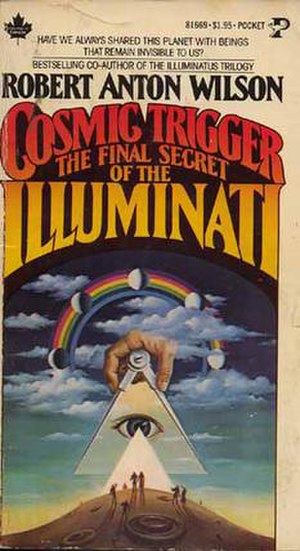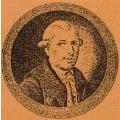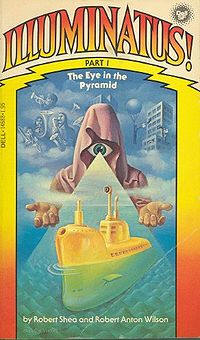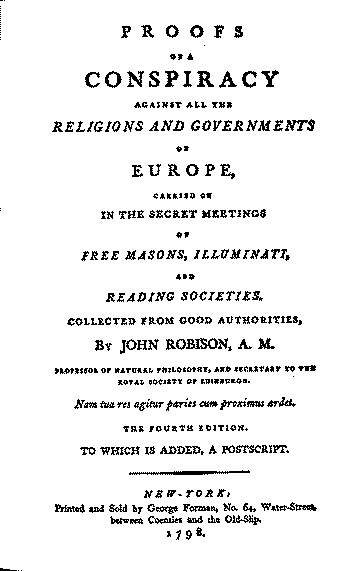 Image via Wikipedia
Image via WikipediaIlluminati history
The Illuminati was a movement founded on May 1, 1776. Much is, retrospectively, made of both the May 1st date later used by the Russian Revolution as well as the 1776 date tying in to the American Revolution. In fact, since there are only 365 days in a year, the Russian Revolution was bound to occur on one date or another which would/could have a connection to some devious scheme. By 1776, the American Revolution was well along in its planning stages and there's no credible link to a group founded in what is today near Munich, Germany. It was begun by Adam Weishaupt who was educated by the Jesuits, not unlike many who sought an education in those days and in that place. His organization was composed of those who were then espousing the ideals of the Enlightenment: freedom of thought and equality amongst classes of people, ideas that were considered by the authorities as being heretical and treacherous, particularly since logical outcome of equality would preclude the continued existence of monarchy. They were ideas which today, anyone reading this website likely espouses: the right to think as one wishes and to exercise - within the bounds of law - their freedom of choice. At that time, though, freethinking was an anathema to those in power and subjected those who would think such heretical thoughts to imprisonment.While some have suggested that the Illuminati was created to overthrow government and/or that they were behind the American Revolution, such ideas are without any real merit. Augustin Barruel and John Robison, even claimed that the Illuminati were behind the French revolution, a claim that Jean-Joseph Mounier dismissed in his 1801 book On the Influence Attributed to Philosophers, Free-Masons, and to the Illuminati on the Revolution of France. Barruel and Robison also wrote - essentially copying each other - trying to tie in Freemasonry to the plot. It is important to note, however, that both writers recognized that it was ONLY the 'Grand Orient'-type of Freemasonry being practiced in parts of France and Germany that was involved: never what we now term 'regular/recognized' Freemasonry stemming from the Grand Lodge of England! Robison, who had joined Freemasonry in his youth, was roundly criticized for his work, even by the Encyclopedia Brittanica for whom he had written articles!
In 1777, Karl Theodor became ruler of Bavaria. He was a proponent of Enlightened Despotism and, in 1784, his government banned all secret societies, including the Illuminati. They had, by then, included the overthrow of political rulers in their goals and it's easy to understand how that could be a tad upsetting to those in charge. How many people were involved in the organization at that point is difficult to say. Some estimates are as high as 2000 but the simple fact is that once it was outlawed, the organization died - as would ANY organization where involvement could lead to a life in wretched prison confinement.
Weishaupt had modeled his group to some extent on Freemasonry and Illiminati chapters drew some of their membership from existing Masonic lodges.
Illuminati conspiracies
 It is well established that by the end of the eighteenth century, the Illuminati had been effectively disbanded. That will surely burst the bubble of those who've come here seeking to find some buried bit of proof that they still exist and are today controlling the world.
It is well established that by the end of the eighteenth century, the Illuminati had been effectively disbanded. That will surely burst the bubble of those who've come here seeking to find some buried bit of proof that they still exist and are today controlling the world.Because of Freemasonry's inadvertent involvement and the misuse of Freemasonry by the Illuminati's founder who had become a Mason, the legends of its continued existence (and influence) persist into the twenty-first century tying the organizations somehow together. In fact, Weishaupt founded the organization and then tried to get the Freemasons involved. He achieved a very limited success in a couple of lodges but was soon seen as a 'user' and his group removed - not unlike the 'fake Masonry' of today, actually!
In the 1950s and 1960s, members of the John Birch Society made much of this supposed 'shadow' organization, using it as an effective substitute for their anti-Semitism. Perhaps some of the confusion regarding the organization is due to the fact that over time, the word illuminati came to be used more expansively for many enthusiasts of Enlightenment, including but not limited to the followers of Emmanuel Swedenborg. Nevertheless, the Illuminati's connection with Freemasonry was date-specific (the late 1700s) and place-specific (what is now Germany); it had NO involvement in Freemasonry elsewhere despite fanciful claims. Even the oft-mentioned 'Proofs of A Conspiracy' written in 1797 by Robison (and the root cause of so much furor in the United States as a result of one Boston Minister's fanciful claims made based on that book) notes that the Illuminati's brand of Freemasonry was NOT the same Freemasonry as found in England and from which all other legitimate Masonic lodges today can trace their ancestry.
Robert Anton Wilson
A HUGE amount of interest in the Illuminati stems, for those today, from Robert Anton Wilson (1932-2007). A self-described agnostic mystic, he was also an author, philosopher and, some would say, a comedian. Many endow Wilson with all-seeing power while others read his works as poking fun at society and those who would blindly read his writings as fact.Because of his professed agnostic beliefs, the claim from the conspiracy-minded religious intolerants has even more fuel than someone else might have given it.
Wilson wrote some 35 books and many other works. His best-known work is the cult classic The Illuminatus! Trilogy: The Eye in the Pyramid, The Golden Apple, Leviathan
In 1977, Wilson published "Cosmic Trigger I : Final Secret of the Illuminati
Briefly, the background of the Bavarian Illuminati puzzle is this. On May 1, 1776, in Bavaria, Dr. Adam Weishaupt, a professor of Canon Law at Ingolstadt University and a former Jesuit, formed a secret society called the Order of the Illuminati within the existing Masonic lodges of Germany. Since Masonry is itself a secret society, the Illuminati was a secret society within a secret society, a mystery inside a mystery, so to say. In 1785 the Illuminati were suppressed by the Bavarian government for allegedly plotting to overthrow all the kings in Europe and the Pope to boot. This much is generally agreed upon by all historians. 1 Everything else is a matter of heated, and sometimes fetid, controversy.Wilson then goes on to create a broad expansion of fantasy which - just as with Dan Brown novels in the early years of 2000 - are accepted as fact. It's a sad state on our ability to think that so many in society can't separate fact from fiction and today blather on with great fear and loathing about the evil Freemason/Illuminati treachery without a single provable example. In fact, some - in order to keep the bubble of fantasy from popping - suggested that RAW was the Grand Master (or inner head) of the Illuminati himself. Wilson always toyed with the accusations, and in typical RAW fashion, he's never denied it outright - finding the whole concept enormously amusing as well as helpful for book sales.
It has been claimed that Dr. Weishaupt was an atheist, a Cabalistic magician, a rationalist, a mystic; a democrat, a socialist, an anarchist, a fascist; a Machiavellian amoralist, an alchemist, a totalitarian and an "enthusiastic philanthropist." (The last was the verdict of Thomas Jefferson, by the way.) The Illuminati have also been credited with managing the French and American revolutions behind the scenes, taking over the world, being the brains behind Communism, continuing underground up to the 1970s, secretly worshipping the Devil, and mopery with intent to gawk. Some claim that Weishaupt didn't even invent the Illuminati, but only revived it. The Order of Illuminati has been traced back to the Knights Templar, to the Greek and Gnostic initiatory cults, to Egypt, even to Atlantis. The one safe generalization one can make is that Weishaupt's intent to maintain secrecy has worked; no two students of Illuminology have ever agreed totally about what the "inner secret" or purpose of the Order actually was (or is . . .). There is endless room for spooky speculation, and for pedantic paranoia, once one really gets into the literature of the subject; and there has been a wave of sensational "ex-poses" of the Illuminati every generation since 1776. If you were to believe all this sensational literature, the damned Bavarian conspirators were responsible for everything wrong with the world, including the energy crises and the fact that you can't even get a plumber on weekends.
One cannot read any of RAW's material without a healthy sense of humor although many, many do. We've noted from the outset of this very website that those with beliefs stemming from white-hot religious fervor or extreme paranoid conspiracy have ZERO sense of humor and wouldn't recognize satire if it were a sausage that hit them in the head. Thus, the internet has a zillion and a half websites all postulating on the existence of an organization that no one has ever seen and which all rational explanations say simply couldn't exist, with or without the all-powerful Freemasons.
Illuminati reading
For a couple of centuries, there's been nothing truly factual about the 18th Century Barvarian Order of the Illuminati except the sometimes hard to find book The Bavarian Illuminati in America: The New England Conspiracy Scare, 1798 In 2009, however, a new work arrived on the scene - and truthfully, it was one that had all the trappings of 'nut case' on it. Its publisher was a very minor one, noted for sensationalist titles. The author - Terry Melanson - is the owner and developer of the "Illuminati Conspiracy Archive" where paranoia and absurdity reign supreme. He is also a noted anti-Mason, having 'foreseen' an occult revival with Freemasonry leading the way. A clear waste of money, I'd concluded at the outset.
In 2009, however, a new work arrived on the scene - and truthfully, it was one that had all the trappings of 'nut case' on it. Its publisher was a very minor one, noted for sensationalist titles. The author - Terry Melanson - is the owner and developer of the "Illuminati Conspiracy Archive" where paranoia and absurdity reign supreme. He is also a noted anti-Mason, having 'foreseen' an occult revival with Freemasonry leading the way. A clear waste of money, I'd concluded at the outset.However, despite my pre-judged conclusions, Perfectibilists is actually pretty good. The author has set aside all of the foolishness usually found on his website and has donewhat appears to be some great detective work. He notes that the Order of the Illuminati (the name to which the Perfectibilists was changed almost immediately) had approximately 2000-3000 members at its peak and he provides the biographies for hundreds of them. In addition, Melanson has sidebar 'excursions' into related topics, some an entire page, discussing things like the difference between the ACTUAL emblem of the Illuminati (the OWL!) and what we today think of as their emblem, that pyramid with the eye.
The book is interesting in that the primary text is less than 170 pages but then there are 'supplements' totaling another 300 pages along with an exhaustive table of contents. Footnotes are scrupulously provided and the professionalism with which this work was created is really quite impressive. Unfortunately, this may be similar to the way Mr. Melanson has provided footnotes about Freemasonry in his various online screeds so one should consider the material with a jaundice eye unless/until validations are made by trained historians - something that Mr. Melanson isn't.
What others say
Online we found an excellent summary of the entire Illuminati Conspiracy theory. We've placed it here with permission of the site owner. Perhaps you'll find it interesting....The Illuminati Freemason Conspiracy
From Public Eye and Political Research Associates:
 The Freemasons began as members of craft guilds who united into lodges in England in the early 1700's. They stressed religious tolerance, the equality of their male peers, and the themes of classic liberalism and the Enlightenment. Today they are a worldwide fraternal order that still educates its members about philosophical ideas, and engages in harmless rituals, but also offers networking for business and political leaders, and carries out charitable activities.
The Freemasons began as members of craft guilds who united into lodges in England in the early 1700's. They stressed religious tolerance, the equality of their male peers, and the themes of classic liberalism and the Enlightenment. Today they are a worldwide fraternal order that still educates its members about philosophical ideas, and engages in harmless rituals, but also offers networking for business and political leaders, and carries out charitable activities.Weishaupt was appointed a professor at the University of Ingolstadt in Germany around 1772 and elevated to the post of professor of Canon Law in 1773 or 1775 (sources conflict), the first secularist to hold that position previously held by clergy. Weishaupt began planning a group to challenge authoritarian Catholic actions in 1775, the group (under a different name) was announced on May 1, 1776. This group evolved into the Illuminati. The Enlightenment rationalist ideas of the Illuminati were, in fact, brought into Masonic lodges where they played a role in a factional fight against occultist philosophy. The Illuminati was suppressed in a series of edicts between 1784 and 1787, and Weishaupt himself was banished in 1785.
Weishaupt, his Illuminati society, the Freemasons, and other secret societies are portrayed by Robison and Barruel as bent on despotic world domination through a secret conspiracy using front groups to spread their influence.
Barruel claimed the conspirators "had sworn hatred to the altar and the throne, had sworn to crush the God of the Christians, and utterly to extirpate the Kings of the Earth." For Barruel the grand plot hinges on how Illuminati "adepts of revolutionary Equality and Liberty had buried themselves in the Lodges of Masonry" where they caused the French revolution, and then ordered "all the adepts in their public prints to cry up the revolution and its principles." Soon, every nation had its "apostle of Equality, Liberty, and Sovereignty of the People."
Robison, a professor of Natural Philosophy at the University of Edinburgh in Scotland, argued that the Illuminati evolved out of Freemasonry, and called the Illuminati philosophy "Cosmo-politism." According to Robison:
"Their first and immediate aim is to get the possession of riches, power, and influence, without industry; and, to accomplish this, they want to abolish Christianity; and then dissolute manners and universal profligacy will procure them the adherents of all the wicked, and enable them to overturn all the civil governments of Europe; after which they will think of farther conquests, and extend their operations to the other quarters of the globe, till they have reduced mankind to the state of one indistinguishable chaotic mass."Robert Alan Goldberg, in his book Enemies Within, summarizes the basic themes of the books by Barruel and Robison:
"Writing in the aftermath of the French Revolution, these monarchists had created a counterhistory in defense of the aristocracy. Winning the hearts and minds of present and future readers would assuage some of the pain of recent defeat and mobilize defenses. The Revolution, they argued, was not rooted in poverty and despotism. Rather than a rising of the masses, it was the work of Adam Weishaupt’s Illuminati, a secret society that plotted to destroy all civil and religious authority and abolish marriage, the family, and private property. It was the Illuminati who schemed to turn contented peasants 'from Religion to Atheism, from decency to dissoluteness, from loyalty to rebellion.' "The major immediate political effect of allegations of an Illuminati Freemason conspiracy in Europe was to mobilize support for national oligarchies traditionally supported by the Catholic Church hierarchy. Across Europe authoritarian governing elites were coming under attack by reformist and revolutionary movements demanding increased political rights under secular laws. The ideas of the Enlightenment were incorporated by the leaders of both the French and American revolutions, and in a sense, these Enlightenment notions were indeed subversive to the established social order, although they were hardly a secret conspiracy. The special status of the Catholic Church in European nation-states was actually threatened by the ideas being discussed by the Illuminati and the rationalist wing of the Freemasons.Several common conspiracist themes emerge from these two books. The Enlightenment themes of equality and liberty are designed to destroy respect for property and the natural social hierarchy. Orthodox Christianity is to be destroyed and replaced with universalism, deism...or worse. Persons with a cosmopolitan outlook--encouraging free-thinking and international cooperation--are to be suspect as disloyal subversive traitors out to undermine national sovereignty and promote anarchy.
Shortly after the Barruel book was published, conspiracy theories about the Illuminati Freemasons were mixed with antisemitism in Europe. This confluence took place much later in the US.

No comments:
Post a Comment